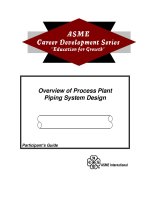overview of process plant - piping system design
Bạn đang xem bản rút gọn của tài liệu. Xem và tải ngay bản đầy đủ của tài liệu tại đây (1.1 MB, 162 trang )
Overview of Process Plant
Piping System Design
Participant’s Guide
CONTACT INFORMATION
ASME Headquarters
1-800-THE-ASME
ASME Professional Development
1-800-THE-ASME
Eastern Regional Office Southern Regional Office
8996 Burke Lake Road – Suite L102 1950 Stemmons Freeway – Suite 5037C
Burke, VA 22015-1607 Dallas, TX 75207-3109
703-978-5000 214-746-4900
800-221-5536 800-445-2388
703-978-1157 (FAX) 214-746-4902 (FAX)
Midwest Regional Office Western Regional Office
17 North Elmhurst Avenue – Suite 108 119-C Paul Drive
Mt. Prospect, IL 60056-2406 San Rafael, CA 94903-2022
847-392-8876 415-499-1148
800-628-6437 800-624-9002
847-392-8801 (FAX) 415-499-1338 (FAX)
Northeast Regional Office
326 Clock Tower Commons
Route 22
Brewster, NY 10509-9241
914-279-6200
800-628-5981
914-279-7765 (FAX)
International Regional Office
1-800-THE-ASME
Y
ou can also find information on
these courses and all of ASME,
including ASME Professional
Development, the Vice President of
Professional Development, and other
contacts at the ASME Web site……
Overview of Process Plant
Piping System Design
By:
Vincent A. Carucci
Carmagen Engineering, Inc.
Copyright © 2000 by
All Rights Reserved
TABLE OF CONTENTS
PART 1: PARTICIPANT NOTES 3
PART 2: BACKGROUND MATERIAL 73
I. Introduction 73
II. General 73
A. What is a piping system 73
B. Scope of ASME B31.3 73
III. Material selection considerations 75
A. Strength 75
B. Corrosion Resistance 77
C. Material Fracture Toughness 77
D. Fabricability 78
E. Availability and Cost 78
IV. Piping Components 79
A. Fittings, Flanges, and Gaskets 79
B. Flange Rating 85
Sample Problem 1 - Determine Flange Rating 88
Solution 88
V. Valves 89
A. Valve Functions 89
B. Primary Valve Types 90
C. Valve Selection Process 98
Exercise 1 – Determine Required Flange Rating 99
VI. Design 100
A. Design Conditions 100
B. Loads and Stresses 101
C. Pressure Design of Components 105
Sample Problem 2 - Determine Pipe wall thickness 110
Sample Problem 3 116
Exercise 2: Determine Required Pipe Wall Thickness 121
VII. System Design 122
A. Layout Considerations 122
B. Pipe Supports and Restraints 123
C. Piping Flexibility 129
D. Required Design Information for Piping Stress Analysis 132
E. Criteria for Allowable Equipment Nozzle Loads 132
F. When Should A Computer Analysis Be Used 134
G. Design Considerations for Piping System Stress Analysis 134
VIII. Fabrication, Assembly, and Erection 140
A. Welding and Heat Treatment 140
B. Assembly and Erection 144
IX. Quality Control 151
A. Inspection 151
B. Testing 154
X. Other Considerations 156
A. Nonmetallic Piping 156
B. Category M Fluid Service 157
C. High Pressure Piping 158
XI. Summary 160
3
Part 1:
Participant Notes
4
1
OVERVIEW OF
PROCESS PLANT PIPING
SYSTEM DESIGN
By: Vincent A. Carucci
Carmagen Engineering, Inc.
Notes:
2
Piping System
Piping system: conveys fluid between
locations
Piping system includes:
•Pipe
• Fittings (e.g. elbows, reducers, branch
connections, etc.)
• Flanges, gaskets, bolting
•Valves
• Pipe supports
Notes:
5
3
ASME B31.3
–Design
– Materials
–Fabrication
– Petroleum refineries
– Chemical plants
– Pharmaceutical plants
– Textile plants
– Paper plants
– Semiconductor
plants
– Cryogenic plants
–Erection
–Inspection
– Testing
• Provides requirements for:
• For process plants including
Notes:
4
Scope of ASME B31.3
• Piping and piping components, all fluid
services:
– Raw, intermediate, and finished chemicals
– Petroleum products
– Gas, steam, air, and water
– Fluidized solids
– Refrigerants
– Cryogenic fluids
• Interconnections within packaged equipment
• Scope exclusions specified
Notes:
6
5
Strength
• Yield and Tensile Strength
• Creep Strength
• Fatigue Strength
• Alloy Content
• Material Grain size
• Steel Production Process
Notes:
6
Stress - Strain Diagram
S
A
B
C
E
Notes:
7
7
Corrosion Resistance
• Deterioration of metal by chemical or
electrochemical action
• Most important factor to consider
• Corrosion allowance added thickness
• Alloying increases corrosion resistance
Notes:
8
Piping System Corrosion
General or
Uniform
Corrosion
Uniform metal loss. M ay be combined with erosion if
high-velocity fluids, or m oving fluids containing
abrasives.
Pittin g
Corrosion
Localized metal loss randomly located on material
surface. Occurs most often in stagnant areas or areas of
low-flow velocity.
Galvanic
Corrosion
Occurs when two d issimilar metals contact each other in
corrosive electrolytic environment. Anodic metal develops
deep pits or grooves as current flows from it to cathodic
metal.
Crevice Corrosion Localized corrosion similar to pitting. Occurs at places
such as gaskets, lap joints, and bolts where crevice
exists.
Concentration
Cell Corrosion
Occurs when different concentration of either a corrosive
fluid or dissolved oxygen contacts areas of same metal.
Usually associated with stagnant fluid.
Graphitic
Corrosion
Occurs in cast iron exposed to salt water or weak acids.
Reduces iron in cast iron, and leaves graphite in place.
Result is extremely soft material with no metal loss.
Notes:
8
9
Material Toughness
• Energy necessary to initiate and
propagate a crack
• Decreases as temperature decreases
• Factors affecting fracture toughness
include:
– Chemical composition or alloying elements
– Heat treatment
– Grain size
Notes:
10
Fabricability
• Ease of construction
• Material must be weldable
• Common shapes and forms include:
– Seamless pipe
– Plate welded pipe
– Wrought or forged elbows, tees, reducers,
crosses
– Forged flanges, couplings, valves
–Cast valves
Notes:
9
11
Availability and Cost
• Consider economics
• Compare acceptable options based on:
– Availability
– Relative cost
Notes:
12
Pipe Fittings
• Produce change in geometry
– Modify flow direction
– Bring pipes together
– Alter pipe diameter
– Terminate pipe
Notes:
10
13
Elbow and Return
Figure 4.1
90° 45°
180° Return
Notes:
14
Tee
Figure 4.2
Reducing Outlet Tee Cross Tee
Notes:
11
15
Reducer
Figure 4.3
Concentric Eccentric
Notes:
16
Welding Outlet Fitting
Figure 4.4
Notes:
12
17
Cap
Figure 4.5
Notes:
18
Lap-joint Stub End
Figure 4.6
Note square corner
R
R
Enlarged Section
of Lap
Notes:
13
19
Typical Flange Assembly
Figure 4.7
Flange
Bolting
Gasket
Notes:
20
Types of Flange
Attachment and Facing
Flange Attachment Types Flange Facing Types
Threaded Flanges Flat Faced
Socket-Welded Flanges
Blind Flanges Raised Face
Slip-On Flanges
Lapped Flanges Ring Joint
Weld Neck Flanges
Table 4.1
Notes:
14
21
Flange Facing Types
Figure 4.8
Notes:
22
Gaskets
• Resilient material
• Inserted between flanges
• Compressed by bolts to create seal
• Commonly used types
– Sheet
– Spiral wound
– Solid metal ring
Notes:
15
23
Flange Rating Class
• Based on ASME B16.5
• Acceptable pressure/temperature
combinations
• Seven classes (150, 300, 400, 600, 900,
1,500, 2,500)
• Flange strength increases with class
number
• Material and design temperature
combinations without pressure indicated
not acceptable
Notes:
24
Material Specification List
Table 4.2
Notes:
16
25
Pressure - Temperature Ratings
Table 4.3
Material
Group No.
1.8
1.9 1.10
Classes 150 300 400 150 300 400 150 300 400
Temp., °F
-20 to 100 235
620 825
290
750 1000 290
750 1000
200 220
570 765
260
750 1000 260
750 1000
300 215
555 745
230
720 965 230
730 970
400 200
555 740
200
695 885 200
705 940
500 170
555 740
170
695 805 170
665 885
600 140
555 740
140
605 785 140
605 805
650 125
555 740
125
590 785 125
590 785
700 110
545 725
110
570 710 110
570 755
750 95
515 685
95
530 675 95
530 710
800 80
510 675
80
510 650 80
510 675
850 65
485 650
65
485 600 65
485 650
900 50
450 600
50
450 425 50
450 600
950 35
320 425
35
320 290 35
375 505
1000 20
215 290
20
215 190 20
260 345
Notes:
26
Sample Problem 1
Flange Rating
New piping system to be installed at
existing plant.
Determine required flange class.
• Pipe Material:
• Design Temperature: 700°F
• Design Pressure: 500 psig
Mo
2
1
Cr
4
1
1 −
−−
−
Notes:
17
27
Sample Problem 1 Solution
• Determine Material Group Number (Fig. 4.2)
Group Number = 1.9
• Find allowable design pressure at
intersection of design temperature and Group
No. Check Class 150.
– Allowable pressure = 110 psig < design pressure
– Move to next higher class and repeat steps
• For Class 300, allowable pressure = 570 psig
• Required flange Class: 300
Notes:
28
Valves
• Functions
– Block flow
– Throttle flow
– Prevent flow reversal
Notes:
18
29
Full Port Gate Valve
1. Handwheel Nut
2. Handwheel
3. Stem Nut
4. Yoke
5. Yoke Bolting
6. Stem
7. Gland Flange
8. Gland
9. Gland Bolts or
Gland Eye-bolts and nuts
10. Gland Lug Bolts and Nuts
11. Stem Packing
12. Plug
13. Lantern Ring
14. Backseat Bushing
15. Bonnet
16. Bonnet Gasket
17. Bonnet Bolts and Nuts
18. Gate
19. Seat Ring
20. Body
21. One-Piece Gland (Alternate)
22. Valve Port
Figure 5.1
Notes:
30
Globe Valve
• Most economic for throttling flow
• Can be hand-controlled
• Provides “tight” shutoff
• Not suitable for scraping or rodding
• Too costly for on/off block operations
Notes:
19
31
Check Valve
• Prevents flow reversal
• Does not completely shut off reverse flow
• Available in all sizes, ratings, materials
• Valve type selection determined by
– Size limitations
–Cost
– Availability
– Service
Notes:
32
Swing Check Valve
Figure 5.2
Cap
Hin ge
Disc
Body
Pin
Seat
Ring
Flow
Direct ion
Notes:
20
33
Ball Check Valve
Figure 5.3
Notes:
34
Lift Check Valve
Figure 5.4
Seat
Ring
Piston
Flow
Direction
Notes:
21
35
Wafer Check Valve
Figure 5.5
Notes:
36
Ball Valve
No. Part Names
1 Body
2 Body Cap
3Ball
4 Body Seal Gasket
5 Seat
6Stem
7 Gland Flange
8Stem Packing
9 Gland Follower
10 Thrust Bearing
11 Thrust Washer
12 Indicator Stop
13 Snap Ring
14 Gland Bolt
15 Stem Bearing
16 Body Stud Bolt & Nuts
17 Gland Cover
18 Gland Cover Bolts
19 Handle
Figure 5.6
Notes:
22
37
Plug Valve
Figure 5.7
Wedge
Molded-In Resilient Seal
Sealing Slip
Notes:
38
Valve Selection Process
General procedure for valve selection.
1. Identify design information including
pressure and temperature, valve function,
material, etc.
2. Identify potentially appropriate valve
types and components based on
application and function
(i.e., block, throttle, or reverse flow
prevention).
Notes:
23
39
Valve Selection Process,
cont’d
3. Determine valve application requirements
(i.e., design or service limitations).
4. Finalize valve selection. Check factors to
consider if two or more valves are
suitable.
5. Provide full technical description
specifying type, material, flange rating,
etc.
Notes:
40
Exercise 1 - Determine
Required Flange Rating
• Pipe:
• Flanges: A-182 Gr. F11
• Design Temperature: 900°F
• Design Pressure: 375 psig
Mo
2
1
Cr
4
1
1 −
−−
−
Notes:









